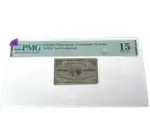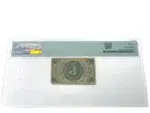1863 – US, 3 Cents, 3rd Issue, Fractional Currency-#1226, PMG 15, CF (#29)
The concept of fractional currency in the United States emerged as a direct response to the economic conditions wrought by the Civil War. During this turbulent period, the Union faced severe coin shortages, primarily in small denominations. This shortage was exacerbated by rampant hoarding of coins, particularly those made of precious metals, as citizens grew increasingly uncertain about the stability of the nation’s currency.
Faced with this pressing issue, the federal government sought a solution to facilitate everyday commerce and transactions. Thus, fractional currency was introduced as a temporary measure to bridge the gap caused by the scarcity of coins. These small-denomination notes, ranging from 3 to 50 cents, were designed to substitute for coins and ensure that economic activities could continue without significant disruption.
The issuance of fractional currency began in 1862, under the auspices of the U.S. Treasury. This move was part of a broader strategy to stabilize the economy and maintain public confidence in the financial system. Fractional currency was unique in its design and purpose; it was smaller in size compared to standard paper currency and specifically intended for low-value transactions.
Overall, fractional currency played a crucial role in sustaining the Union’s economy during the Civil War. It provided a practical solution to the coin shortage and helped to alleviate the financial strain on both the government and the public. The issuance of these notes not only addressed immediate economic needs but also set a precedent for innovative monetary solutions in times of crisis. The 1863 U.S. 3 Cents 3rd Issue Fractional Currency stands as a testament to this critical period in American financial history, reflecting the challenges and adaptive measures of the era.
The Economic Context of 1863
The year 1863 was marked by significant economic turbulence in the United States, largely attributable to the ongoing Civil War. The conflict, which began in 1861, had far-reaching effects on the nation’s financial stability. One of the most pressing issues was the acute shortage of coinage, which became a critical concern as the war progressed. Citizens, wary of the uncertain future, began to hoard precious metals such as gold and silver, leading to a severe scarcity of coins in circulation. This hoarding was driven by both the fear of inflation and the desire to safeguard wealth in tangible assets.
The dearth of coinage posed substantial challenges for everyday transactions. Merchants and consumers alike faced difficulties in conducting routine business, as the lack of small denomination coins made it nearly impossible to provide correct change. This shortage disrupted commerce and added to the economic strain already imposed by the war. The federal government recognized the necessity of addressing this issue promptly to sustain economic activities and prevent further deterioration of public confidence in the financial system.
In response, the U.S. Treasury introduced fractional currency, a pragmatic solution designed to alleviate the coin shortage. Fractional currency, also known as “shinplasters,” consisted of paper notes in denominations less than one dollar. The introduction of these notes provided a temporary but effective means to facilitate smaller transactions, ensuring that commerce could continue despite the ongoing coinage crisis. The 1863 U.S. 3 Cents 3rd Issue Fractional Currency emerged as part of this broader effort to stabilize the economy during a period of unprecedented turmoil.
This economic backdrop underscores the significance of fractional currency in 1863. It was not merely a financial instrument but a vital component in maintaining the flow of goods and services amidst the chaos of war. The issuance of fractional currency, including the 3 Cents note, highlights the government’s adaptive strategies to mitigate the economic challenges posed by the Civil War, reflecting a critical chapter in the monetary history of the United States.
Design and Features of the 3 Cents Fractional Currency
The 1863 U.S. 3 cents 3rd issue fractional currency is a notable example of early American paper money. Measuring approximately 41 x 89 mm, this currency was relatively small compared to modern standards, yet it was intricately designed to serve its purpose effectively. The paper used was a blend of cotton and linen, which provided durability and a distinct texture, making it harder to counterfeit.
The design of the 3 cents fractional currency is marked by its detailed and aesthetic elements. The obverse side prominently features a portrait of George Washington, which was chosen to instill a sense of trust and familiarity among the public. Washington’s portrait is encased in an ornate frame, showcasing the artistic craftsmanship of the period. Surrounding the portrait, intricate patterns and fine lines were employed not only for decoration but also as a deterrent to counterfeiting.
The reverse side of the note is equally significant, featuring elaborate geometric designs and intricate line work. The denomination “3” is boldly displayed in each corner, ensuring easy recognition. Additionally, the denomination is spelled out in text at the center of the note, further enhancing its readability. These design choices were intentional, aiming to reduce the risk of fraudulent reproduction.
To further secure the currency against counterfeiting, the 3 cents fractional currency incorporated several advanced security features for its time. One notable feature was the use of blue fibers embedded within the paper, which were visible to the naked eye. These fibers made it significantly more challenging to replicate the currency using contemporary printing techniques. Another security measure included intricate micro-printing, which provided additional protection against unauthorized duplication.
Overall, the 1863 U.S. 3 cents 3rd issue fractional currency stands out not only for its historical significance but also for its detailed design and advanced security features. These characteristics reflect the efforts of the U.S. government to maintain the integrity and trustworthiness of its currency during a tumultuous period in American history.
The Third Issue of Fractional Currency
The third issue of fractional currency, which includes the 1863 U.S. 3 cents note, represents a significant phase in the U.S. Treasury’s efforts to address the coin shortage during the Civil War. Introduced between December 1864 and August 1869, this issue encompassed a range of denominations including 3 cents, 5 cents, 10 cents, 15 cents, 25 cents, and 50 cents notes. This period was marked by a scarcity of metal coins, as they were hoarded by the public, necessitating the creation of fractional currency to facilitate everyday transactions.
One of the primary reasons for issuing fractional currency was to provide a practical solution for small change transactions, given the diminished availability of coins. The third issue, in particular, was notable for its distinct design features and enhanced security measures. Unlike the previous issues, this series incorporated more advanced anti-counterfeiting elements such as intricate designs, more detailed engravings, and the use of distinctive paper materials. These improvements were vital in maintaining public trust and reducing the risk of counterfeiting, which had been a significant problem with earlier issues.
The 1863 U.S. 3 cents note stands out within the third issue for its unique place in the history of American currency. It is the lowest denomination ever issued by the U.S. government and was introduced to meet the specific demand for lower-value transactions. This note, along with its counterparts in the third issue, featured prominent figures and patriotic themes, reflecting the turbulent yet resilient spirit of the nation during the Civil War era.
In comparison to subsequent issues, the third issue fractional currency was both a continuation and an evolution in the design and functionality of U.S. paper money. It laid the groundwork for future advancements in currency production and design, setting a precedent for the careful balance between aesthetic appeal and security features. The 1863 3 cents note, along with other denominations from this issue, remains a fascinating artifact for collectors and historians alike, providing a tangible link to a pivotal period in U.S. monetary history.
The 1863 U.S. 3 Cents 3rd Issue Fractional Currency is a fascinating artifact not only for its historical context but also for the notable figures and symbols that adorn it. One of the most prominent figures featured on this note is the portrait of George Washington, the first President of the United States. Washington’s inclusion is significant as it underscores his enduring legacy and the nascent nation’s reliance on his image to instill trust and stability during a tumultuous period in American history.
Another key figure represented on the 3 Cents note is the allegorical female figure known as “Liberty.” This personification is depicted holding a shield emblazoned with the stars and stripes of the American flag, symbolizing the nation’s enduring strength and unity. The figure of Liberty was a common motif in American iconography of the era, embodying the ideals of freedom, democracy, and the fight for a just society.
Additionally, the note features intricate symbolic imagery that further enhances its historical and cultural significance. Noteworthy among these symbols is the presence of the American eagle, a traditional emblem of the United States, signifying courage, freedom, and the nation’s sovereignty. The eagle is often depicted with outstretched wings, clutching arrows and an olive branch, conveying a balance between war and peace.
The intricate design elements of the 3 Cents note also include various patriotic iconography such as the shield, stars, and intricate scrollwork, which were intended to evoke a sense of national pride and security. The use of these symbols during the Civil War era was particularly poignant, as the nation grappled with internal division and sought to reinforce a collective identity through common symbols of heritage and values.
In examining the 1863 U.S. 3 Cents 3rd Issue Fractional Currency, one gains a deeper appreciation for the deliberate choice of figures and symbols that were not merely decorative but carried profound significance. These elements collectively served to reaffirm national unity and the foundational principles upon which the United States was built.
Production and Distribution
The 1863 U.S. 3 cents 3rd issue fractional currency was an innovative response to the coin shortage during the Civil War. As metal coins became scarce, the U.S. government introduced fractional currency as a temporary solution. The production of these notes was handled by the Bureau of Engraving and Printing (BEP), which was established to create secure and standardized currency.
The printing process for the 3 cents fractional currency involved meticulous craftsmanship. The BEP utilized high-quality paper and advanced printing techniques of the time to prevent counterfeiting. The notes featured intricate designs, including portraits and ornate borders, which added layers of complexity and security. The primary materials used were a blend of cotton and linen, ensuring durability and longevity even with frequent handling.
Distribution of the 3 cents fractional currency was carefully managed to ensure widespread availability. These notes were distributed through various channels, including postal offices and banks, which played a crucial role in circulating them among the public. Postal offices, in particular, were instrumental because they were accessible to a broad segment of the population, ensuring that even in rural areas, people could obtain and use these smaller denominations.
Circulation of the 3 cents fractional currency was facilitated by the everyday transactions of the public. These notes were frequently used for small purchases and everyday exchanges, filling the gap left by the absent coins. Their ease of use and the trust instilled by their secure production made them an essential part of the economic landscape during and after the Civil War.
The successful production and distribution of the 1863 3 cents fractional currency highlight the innovative measures taken by the government to adapt to economic challenges. This fractional currency not only addressed the immediate need but also paved the way for future developments in U.S. currency production and distribution.
The Legacy and Collectibility of the 1863 3 Cents Fractional Currency
The 1863 3 cents fractional currency holds a unique place in the annals of American financial history. Issued during the tumultuous period of the Civil War, this fractional currency reflects the U.S. government’s innovative response to a severe coin shortage. The issuance of such currency was not merely a stopgap measure but a significant step towards modernizing the nation’s monetary system. These small denomination notes, including the 3 cents variety, facilitated everyday transactions when coins were hoarded or unavailable.
Historically, the introduction of the 3 cents fractional currency marked a pivotal moment in the broader narrative of U.S. currency evolution. It demonstrated the government’s adaptability and willingness to implement unconventional solutions during economic crises. This particular issue is also notable for its intricate designs and anti-counterfeiting features, which were advanced for the time and reflect the technological advancements in printing and currency production of the era.
Today, the 1863 3 cents fractional currency is highly esteemed among collectors. Its value and rarity have only increased over time, driven by its historical significance and the limited number of surviving examples. Collectors and historians alike prize these notes not only for their monetary value but also for the rich stories they tell about the American economy during the Civil War. Factors such as condition, rarity, and historical context contribute to the desirability and market value of these notes.
In the contemporary collectibles market, the 3 cents fractional currency is a coveted item. Auctions and private sales frequently feature these notes, and they often command substantial prices. Collectors seeking to acquire this piece of history must navigate a competitive landscape, where provenance and preservation are key considerations. Thus, the legacy of the 1863 3 cents fractional currency endures, serving as a tangible link to a formative period in U.S. economic history and a prized artifact for numismatists.
Conclusion: The Impact of Fractional Currency on U.S. Economy
The introduction of fractional currency, including the notable 1863 U.S. 3 Cents 3rd Issue note, played a pivotal role in stabilizing the U.S. economy during the tumultuous Civil War period. As discussed earlier, the scarcity of coinage necessitated innovative solutions, and fractional currency emerged as a practical and timely response. These small-denomination notes helped alleviate the severe coin shortage, ensuring that day-to-day transactions could continue smoothly, and provided the public with a reliable medium of exchange amidst the financial uncertainty.
The 1863 3 cents note, along with other denominations, served to bridge the gap created by the hoarding of coins and the suspension of specie payments. By enabling continued commercial activities, fractional currency supported the broader war effort by maintaining economic stability. Additionally, the issuance of these notes marked significant advancements in printing and security features, which laid the groundwork for future currency innovations.
While fractional currency was instrumental during the Civil War, it was eventually phased out as the economy stabilized and coinage became more readily available. By the late 19th century, the need for fractional currency diminished, and it was systematically replaced by other forms of money, including more durable and secure paper currency. This transition underscored the evolution of the U.S. monetary system and highlighted the government’s adaptability in addressing economic challenges.
In summary, the 1863 U.S. 3 Cents 3rd Issue fractional currency was more than just a temporary solution; it was a critical element in ensuring economic continuity during one of the nation’s most challenging periods. Its impact on the U.S. economy underscores the importance of flexible and innovative monetary policies in responding to crises, a lesson that remains relevant to this day.

























Matt (verified owner) –
Their descriptions are accurate, and the photos of the banknotes are clear and detailed, so I always know what to expect
briane (verified owner) –
I appreciate that they offer a range of conditions for each banknote, accommodating different collector preferences
Diana (verified owner) –
Whether you’re a seasoned collector or just starting out, this site is a fantastic place to find unique pieces of currency history. I’ve never been disappointed!